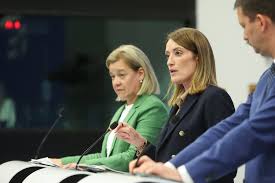The European Parliament supports new ways to fund the EU

The European Parliament sees the need for new sources of EU budget revenue so that the EU can pay back existing debt and keep investing in what matters.
Press conference on the next EU long-term budget (MFF): outcome of the vote on Parliament’s priorities
Parliament President Roberta Metsola (middle) with MEPs Carla Tavares (left) and Siegfried Mureşan (right) in Strasbourg, May 2025.
The EU budget is financed through a system of revenue known as “own resources”. In the negotiations on the post-2027 long-term budget, the European Parliament wants new types of own resources introduced.
What are the EU budget’s own resources?
EU countries contribute to a common EU budget in order to achieve common objectives. Unlike national budgets, the EU budget is an investment budget and is not permitted to run a deficit. The EU treaties stipulate that the Union’s budget “shall be financed wholly from own resources”.
Read how Parliament works to prepare the next EU long-term budget Opens in a new window
These revenue sources are determined by the Council, acting unanimously having consulted the Parliament, and must be ratified also by each EU country. The system of own resources had remained largely unchanged for three decades until a new sources of revenue based on plastic packaging waste was added in 2021. Parliament has been calling for an overhaul of the system.
What own resources already exist?
As the EU budget must always be in balance, annual revenue must completely cover annual expenditure.
EU revenue presently consists of the following:
Traditional own resources (mainly customs duties, previously also included sugar levies)
VAT-based own resource (transfer of a percentage of the estimated VAT collected by EU countries)
GNI-based own resource (EU countries transfer a share of their annual gross national income; the largest own resource)
Plastic-based own resource (a national contribution based on the amount of non-recycled plastic packaging waste)
Other revenue (includes fines to companies breaching EU competition law, contributions of non-EU countries to certain EU programmes and taxes on EU staff’s salaries)
Some EU countries – Austria, Denmark, Germany, the Netherlands and Sweden – currently benefit from rebates on their contributions to the EU budget.
The revenue source based on non-recycled plastic packaging waste is the most recent one and has been in place since 1 January 2021. It has encouraged reducing single-use plastics, as well as recycling and also boosted the circular economy.
What are the proposed new ways to fund the EU?
Parliament has believed for a long time that the EU revenue system in need of reform in order to better tackle current challenges and achieve meaningful results for Europeans.
To reduce reliance on contributions based on gross national income and VAT from EU countries, Parliament called for the introduction of new revenue sources linked to EU policies and objectives.
There have been different ideas for new own resources, including:
The proceeds of the Emissions Trading System (revenue from the system which restricts the volume of greenhouse gases that can be emitted by for example energy-intensive industry, power producers and airlines)
Digital services taxation (ensuring fair taxation of the digital economy)
The carbon border adjustment mechanism (a carbon price on imports of certain goods from outside the EU, which helps ensure a level playing field in the fight against climate change)
A financial transaction tax (ensuring the financial sector pays its fair share of taxes)
An own resource linked to revenue from corporate taxation
In May 2023, the Parliament approved a report that calls for an assessment of the reform process so far, and also proposes some fresh ideas for additional revenue sources such as a tax on crypto assets.
In June 2023, the Commission submitted a proposal for new sources of budget revenue:
Based on revenue from emission trading (ETS): 30% of the revenue from auctions of ETS allowances would be allocated to the EU budget.
Generated by the EU carbon border adjustment mechanism (CBAM). 75% of the revenue from the mechanism would be allocated to the EU budget.
Linked to company profits: for the moment it would be based on a statistical estimate approximating company profits; later it could be linked to an initiative to simplify corporate tax rules.
Parliament supported the Commission proposal, although MEPs underlined that the rules on reducing the net contributions of EU countries through rebates or corrections should be revised.
All EU countries need to agree on adding new sources of income to the EU budget for it to enter into force. So far, there has been no agreement on this in the Council.
In May 2025, Parliament adopted a resolution containing its priorities for the post-2027 long term budget. Here Parliament called on the Council to urgently adopt new own resources in order to enable sustainable repayment of EU debt, and stressed that new own resources are essential for the Union’s higher spending needs.
“Our next long-term budget must be responsible towards future generations. Fiscal discipline isn’t a choice. It is a duty. We need new resources for old debt. This has been promised for years. It is now time to advance and deliver on this,” European Parliament President Roberta Metsola told a press conference following the plenary vote.





